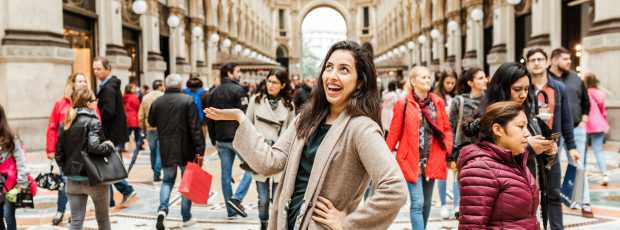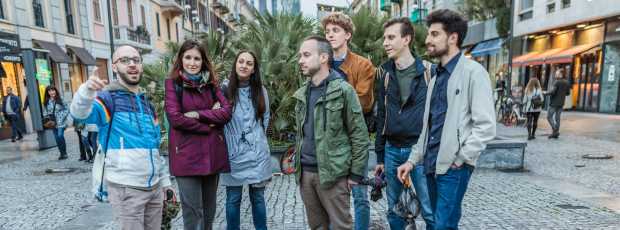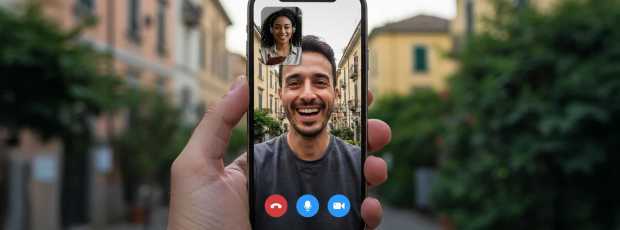We loved Tiziana because she was so REAL and also enthusiastic and easy to listen to. Also very sweet.Janet, Milan, 2025
Table Of Contents
- Milan’s Best Kept Secrets: Must-See Hidden Spots and Local Favorites
- Explore Milan’s Hidden Corners and Secret Gardens: A Journey Off the Beaten Path
- What to Do in Milan: Discover the City’s Best Non-Touristy Spots
- Milan’s Shopping Secrets: Local Finds and Iconic Milanese Products
- Practical Tips for Exploring Milan
- Frequently Asked Questions About Hidden Gems in Milan
- Milan's Hidden Gems: A Blend of Old and New
Last Tuesday, I watched a tourist photograph the Duomo for the fourteenth time while standing in front of a doorway that leads to one of the most beautiful courtyards in Milan. The door was open. He never looked. Milano doesn't hand over its secrets to anyone in a hurry. These hidden gems in Milan are what keep locals like me rooted here, even when the crowds make the city center feel like a shopping mall at Christmas. The Milan experiences I treasure most happen in these quiet corners of the city.

Quiet Milan courtyard, inviting you to explore the city’s hidden gems
Milan’s Best Kept Secrets: Must-See Hidden Spots and Local Favorites
The most famous monuments matter, but the way most tourists experience them misses the point. The best hidden gems in Milan often remain hidden in plain sight, right next to the places everyone photographs.
Castello Sforzesco: Discovering Hidden Corners and Unseen History
Castello Sforzesco and the Duomo deserve your time, of course, but approach them with curiosity rather than checking boxes. At Castello Sforzesco, most people rush through without seeing the inner courtyards or museum collections. They miss the historic cannonball set in the military wing, the Renaissance art, and the ancient Egyptian artifacts that rival collections anywhere in Italy. The castle deserves a full morning before you even consider Milan day trips to Lake Como or other destinations.

Castello Sforzesco’s inner courtyard with historic architecture and quiet charm
Santa Maria delle Grazie: Explore the Hidden Garden and Renaissance Charm
Santa Maria delle Grazie, located on Corso Magenta, is home to Leonardo da Vinci's 'The Last Supper.' But what most visitors miss is the church itself and the cloister garden behind it. I took a client there last spring after a stressful showroom visit, and we sat on a stone bench for twenty minutes without speaking. The garden has that effect. The Renaissance architecture alone makes it one of the most beautiful churches in northern Italy.

Santa Maria delle Grazie cloister garden in morning light
Piazza Santo Stefano: Milan’s Tranquil Oasis Away from the Crowds
Not far away, you can reach Piazza Santo Stefano, which somehow stays quiet even on weekends. I bring my tour groups here between boutique visits when we need espresso. There's a bar on the corner where the barista knows my order, and the square has an unhurried feeling that's rare in central Milan. The Chiesa di San Bernardino alle Ossa is just a short walk away, and that's where things get genuinely strange.

Peaceful Piazza Santo Stefano, offering a quiet escape in central Milan
The Devil’s Column: Milan’s Eerie Hidden Legend
Here's something most people miss entirely. Near Sant'Ambrogio, there's a severed stone column with two clearly visible holes in it. Locals call it the Devil's Column, and according to legend, the visible holes were made by the devil's horns. I pass it regularly and always see people peeking at the holes, attempting to peer through them. Sounds made up until you're standing right in front of it.

The mysterious Devil’s Column with visible holes, steeped in Milanese legend
Because No Two Travelers Are the Same
We help you shape a city day that matches your pace, your style, and your curiosity, not a fixed route.
Explore Milan’s Hidden Corners and Secret Gardens: A Journey Off the Beaten Path
Turn down the right streets, and you'll discover what makes Milan more than just fashion weeks and aperitivo hour. These secret places range from medieval chapels to modernist towers and hidden courtyards, each revealing a different layer of the city's character. Architecture spanning eight centuries, all within walking distance.
Chiesa di San Bernardino alle Ossa and Its Quiet Streets
The Chiesa di San Bernardino alle Ossa is not for everyone. The entire chapel is decorated with human skulls and bones, arranged in geometric patterns along the walls and ceiling. The first time I went to San Bernardino, I was seventeen, trying to impress a boyfriend. I lasted about three minutes before needing air. Now I bring clients here regularly.
The ossuary dates back to the 13th century, when a nearby cemetery ran out of space. The temperature drops noticeably when you step inside. Nothing else in Italy compares to it. There's this particular silence that feels heavier than normal quiet, and in late afternoon, light hits the bones at an angle that makes them almost golden.

Ossuary chapel interior with bone decorations and baroque details
Right outside the church is Vicolo di San Bernardino, a narrow street that feels completely removed from the modern city. Laundry hangs from windows. A cat sleeps in a patch of sun. I've used it as a shortcut for years, and it remains one of Milan's most secluded streets where tourists never venture.
Milan’s Private Gardens and Modernist Icons: Hidden Beauties in Plain Sight
Villa Necchi Campiglio is a 1930s villa tucked away behind an anonymous gate near Corso XXII Marzo. Designed by Piero Portaluppi for Angelo Campiglio and the Necchi family, it represents everything I love about Milanese modernism. Clean lines, perfect proportions, nothing excessive. But the real treasure is the private garden.
I proposed a fashion shoot here once, and we spent the entire morning scouting locations because every angle was perfect. The private swimming pool at Villa Necchi resembles something from a Slim Aarons photograph. Visit on a weekday morning if you can. The villa operates as a house museum now, rooms and gardens frozen exactly as they were in the Thirties.

Bosco Verticale towers with lush greenery on balconies
The Bosco Verticale, or Vertical Forest, towers over the Porta Nuova district. Most people just take a photo from Piazza Gae Aulenti and move on. The project, designed by Stefano Boeri, houses more than 20,000 plants that filter pollution. In spring, the buildings glow green. In the fall, there are rust-colored leaves on a skyscraper. It's become an icon of sustainable architecture across Europe.
Casa degli Atellani is another private garden that feels like stepping into a different century. Leonardo da Vinci once tended Leonardo's vineyard here, which has been replanted using the original grape varieties. I came for a magazine assignment last year and ended up staying two hours past the interview, just sitting in the garden. The house preserves centuries of Italian history in its rooms and terraces.
Villa Invernizzi: A Surreal Tropical Oasis with Pink Flamingos
Villa Invernizzi sounds too strange to be real. Tucked away on Via dei Cappuccini near Porta Venezia, it has a secret courtyard with pink flamingos in the middle of Milano. Yes, pink flamingos. The garden also boasts palm trees and exotic plants, creating a surreal tropical oasis in northern Italy.

Villa Invernizzi’s secret courtyard with pink flamingos and tropical greenery
You can't go inside, but you can see the pink flamingos through the gate. I always bring my tour groups here because those flamingos prove that Milan has a sense of humor beneath all that fashion industry polish.
Palazzo Sola Busca: Milan’s Acoustic Secrets and Renaissance Wonders
Another hidden gem worth seeking out is Palazzo Sola Busca, also known as the rabbi's house. In Milanese dialect, locals call it "ca de l'oreggia," which means "house of the ear" because of its remarkable acoustic properties. Stand in one corner and whisper, and someone across the courtyard will hear you perfectly. The palazzo's Renaissance architecture shows what 16th-century Italian engineers could do when they understood sound better than we do now with all our technology.

Palazzo Sola Busca’s Renaissance architecture
While you're exploring the city center, keep an eye out for Palazzo Acerbi on Via Brera, another architectural treasure with beautiful frescoes that most people walk past without noticing
Walking along Carlo Poerio toward the Quadrilatero will show you Milano's quieter side better than any museum.
What to Do in Milan: Discover the City’s Best Non-Touristy Spots
The best way to understand Milan is to see how locals move through the city. These neighborhoods show you the city when it's not performing for anyone. What life in Italy's most modern city feels like, far from the typical tourist attractions.
Explore the Quadrilatero del Silenzio: Milan’s Quiet, Artistic Neighborhood
If you want to see what Milano looks like when it's not performing for tourists, head to the Quadrilatero del Silenzio. This residential neighborhood near Porta Venezia, just off Via Carlo Poerio, is full of Art Nouveau and Art Deco architecture, wide streets lined with trees, and absolutely no commercial activity. I bring every design tour group here now. Walking along Carlo Poerio toward the Quadrilatero will show you Milano's quieter side better than any museum.

Quiet Art Nouveau street in Quadrilatero del Silenzio neighborhood
The buildings have details you don't see in newer construction. Wrought iron balconies, original tilework, stained glass windows that catch afternoon light. It costs nothing to walk through here, but you'll understand more about Milan than most paid attractions teach you. The area is particularly beautiful in Milan at night when the Art Nouveau streetlamps illuminate the architecture. Near the Quadrilatero, you'll occasionally spot sculptures, including the black horses fountain that locals use as a meeting point.
Wander Through the Maggiolina District
The Maggiolina District consists of low terraced houses built as temporary housing units after World War II. Engineer Mario Cavallè designed the Maggiolina with its distinctive circular layout. The buildings here are postwar and functional, and the area has an authenticity that wealthier parts of Italy lack.

Maggiolina District’s postwar terraced houses and authentic local charm in Milan
My aunt lived here when I was growing up, and her local grocer knew everyone's names. That still exists in the Maggiolina. Family-run restaurants, bars where construction workers stop for morning coffee, and a general lack of pretension that's refreshing. Want to see how locals live in this part of Milan? This is where you come, not the polished Milan neighborhoods that appear in guidebooks.
Visit Casa Rossi: Milan's Hidden Art Spaces
Casa Rossi is technically an art space, but it functions more like a salon. Openings at Casa Rossi feel more like dinner parties, with maybe twenty people and wine from someone's uncle's vineyard. The last show I went to was in a back room with terrible lighting and the best conceptual photography I'd seen in months.
When you're exploring the Brera neighborhood, don't miss the Pinacoteca di Brera. It's one of Milan's great art museums, and the collection includes works by Caravaggio and Raphael. The museum sits right in the heart of di Brera, surrounded by cobblestone streets and art studios. If you're interested in Milan's creative history, you might also want to look up Ettore Conti's studio, which was an important space for early 20th-century Milanese artists.

Quiet Pinacoteca di Brera art space in Brera
The restaurants in Milano range from traditional trattorias near Corso Magenta serving risotto alla milanese to the restaurants in the Brera neighborhood where I live that mix Italian tradition with contemporary techniques. If you're wondering what to eat in Milan, start with these neighborhood places where locals have been eating for generations. Eating at these local spots ranks among the most authentic things to do in Milan..
Don’t Just Visit. Feel Part of It.
Locals share their city as they live it, so even a few hours can feel like you truly belong.
Milan’s Shopping Secrets: Local Finds and Iconic Milanese Products
Milano's shopping culture extends far beyond the luxury flagships. The city's real treasures are found in workshops where craftsmanship matters more than labels. Italy has always been known for artisan work, and Milano maintains that tradition even as it influences fashion across Europe.
Handcrafted Leather Goods and Milan Artisans
Handcrafted leather goods are everywhere if you know where to look. I have a leather portfolio I bought from a workshop near Milan eight years ago, and it looks better now than it did when new. The craftsman showed me how he cuts each piece, conditions the leather, and hand-stitches the seams. Knowledge passed down through generations, visible in every stitch.

Artisan leather workshop with handcrafted bags and accessories
Ceramics are another local specialty tourists often miss. Milano has a tradition of ceramic work that goes back centuries. I have a collection of plates from a ceramicist in Navigli that I use every day. They're slightly irregular, which means they were made by hand. The same goes for Milanese chocolate. There are chocolatiers here perfecting their recipes for generations, making gianduja and pralines that connect you to Milano's traditions and to Italy's broader culinary heritage.
Plan Smarter, Travel Better
Chat with someone who lives there and avoid wasting time on tourist traps.
Vintage Fashion and Design Objects in Milan
For vintage fashion, try Cavalli e Nastri in Brera. The owner, Rossana, has an eye for pieces that work in a contemporary wardrobe. Just beautifully made clothes from the Seventies and Eighties that fit better than most things being made now in Italy or anywhere else in Europe. Tailored jackets I wear on my design tours came from here, and clients always ask where they're from. That's what's famous in Milan to buy. Quality that lasts decades.

Vintage fashion and Italian design treasures at Cavalli e Nastri in Brera
The city also has a strong tradition of design objects. Milano hosts the annual Salone del Mobile, the world's largest furniture fair, and that design consciousness filters down into everyday life. Before visiting, browse shops and galleries online to identify pieces that interest you, then see them in person throughout the city, both vintage and modern works that showcase decades of Italian design.
Make Milan Yours
Skip the scripts. With City Unscripted, every walk, stop, and story is shaped around you, not a tour schedule.Practical Tips for Exploring Milan
Getting around Milano to experience these hidden gems in Milan is easier than you might think. Thirty-three years of figuring out the best routes means I can save you time and wrong turns.
Getting Around
- Milan's Public Transport System: The metro, trams, and buses connect most hidden gems efficiently. I use the M5 line to Porta Nuova station for Bosco Verticale, and the M1 gets you close to Corso Magenta for the church. A day pass is a great idea if you're hopping between neighborhoods.
- Walking Routes: The city center is compact, so I walk everywhere. Villa Necchi Campiglio near Corso XXII Marzo is accessible via tram, but I usually walk from the metro. That's how I found half the places featured in this article.
- Hidden Streets on Foot: These narrow lanes and the secluded streets around the bone chapel aren't on any bus route. Walking is the only way to find them, and that's the point

Milan's efficient public transport: The Milan metro
Best Time to Visit
- Early Mornings: Get to the church and the bone chapel early to avoid crowds. The ossuary is particularly atmospheric in late afternoon when light hits the interior at an angle.
- Afternoon Retreats: Milano's secret courtyards and gardens at Villa Necchi Campiglio and Casa degli Atellani are perfect for peaceful escapes during leisure time. I often bring clients here between meetings when we need to reset.
- Pink Flamingos at Dawn: The pink flamingos are most active in the morning. I see people peeking through the gate whenever I walk past on Via dei Cappuccini.

Casa degli Atellani’s peaceful courtyard and tranquil mornings
Accessibility
- Pedestrian-Friendly Areas: These narrow lanes and the neighborhood are pedestrian-friendly, but cobblestones can be challenging for those with mobility issues.
- Public Transport Access: Milano's public transport offers step-free access at many stations for easier exploration, though not all historic buildings have elevators.
- Historic Buildings: Villa Necchi Campiglio and Casa degli Atellani have some accessibility limitations due to their architecture. I always tell people to call ahead if they have specific needs

Milan's accessible public transport for all visitors
Frequently Asked Questions About Hidden Gems in Milan
1) How much does it cost to visit Villa Necchi Campiglio?
Entry costs around €10 for adults, with discounts for students and seniors. The ticket includes access to both the villa interior and the private garden with its swimming pool.
2) Can you swim in the pool at Villa Necchi Campiglio?
No, the private swimming pool is part of the museum and not open for public swimming. It's preserved as part of the historic 1930s villa.
3) Are the pink flamingos at Villa Invernizzi real?
Yes, the pink flamingos are real live birds that have lived in the garden for decades. You can see them through the gate on Via dei Cappuccini.
4) Is the bone chapel appropriate for children?
The ossuary with human skulls might be disturbing for young children. I'd recommend it for teenagers and adults comfortable with macabre art.
5) How far in advance should I book The Last Supper in Milan?
Book at least two to three months in advance, especially during peak season from April to October. Same-day tickets are nearly impossible.
6) Is there an entrance fee for the bone chapel?
The church is free to enter, though donations are appreciated. It's open during regular church hours.
7) Can you visit Leonardo's vineyard at Casa degli Atellani year-round?
Casa degli Atellani and Leonardo's vineyard are open to visitors, but hours vary seasonally. Check ahead as the site sometimes closes for private events.
8) Are there restaurants near the piazza?
Yes, the square has cafés perfect for espresso and light meals. The neighborhood also has traditional trattorias within a short walk.
9) Is the Quadrilatero del Silenzio safe to walk through at night?
This is a residential neighborhood and very safe, even at night. It's one of Milano's quieter areas with families.
10) How long should I spend at Bosco Verticale?
Most visitors spend 15-30 minutes viewing the Vertical Forest from street level and Piazza Gae Aulenti. It doesn't require much time unless you're dining nearby.
11) Does Villa Invernizzi ever open to the public?
The villa remains a private residence and never opens for public tours.
12) What's the best way to see multiple hidden gems in one day?
Start early with the church on Corso Magenta, use public transport to reach Bosco Verticale in Porta Nuova, then return to central Milano for Villa Necchi Campiglio, and end with the bone chapel.
13) Are there guided tours of Milan's hidden gems?
Private walking tours focusing on hidden gems in Milan are available through local guides. I sometimes lead design-focused tours, including the neighborhood.
14) Can you take photos inside the ossuary?
Photography is generally allowed inside for personal use, but flash photography may be prohibited. Check with the staff first.
15) Is the Maggiolina District worth visiting if I have limited time?
The Maggiolina District is fascinating for architecture enthusiasts, but if you're short on time, prioritize central hidden gems like Villa Necchi Campiglio and the Art Nouveau neighborhood.
Milan's Hidden Gems: A Blend of Old and New
I've watched Milano change over the years, becoming more international and expensive, but these hidden corners remain. They exist in the gaps between the most famous monuments, in neighborhoods where people live and work. From the bone chapel to the pink flamingos at Villa Invernizzi, from Leonardo's vineyard at Casa degli Atellani to the Vertical Forest at Bosco Verticale, Milano blends old and new in ways that never stop surprising me.

Small side street in the Porta Romana neighbourhood
The best Milan experiences happen when you stop trying to see everything and start paying attention to something. That narrow street you almost walked past. The door that's slightly open. This is the Milano I know, the city I choose every day. It's not the Milan of guidebooks or Instagram, but it's the one that matters.
Still here, waiting behind every unmarked door, revealing itself slowly to anyone curious enough to discover what makes this corner of Italy so endlessly fascinating. These Italy experiences transform visits into understanding. Milan’s hidden gems are here, ready for you to uncover and explore.
Explore More of Italy
Ready to Plan Your Perfect Day in Milan?
Start your experienceWhat If Your Day in Milan Was Planned by Someone Who Knows It — and You?
City Unscripted matches you with a local host who creates a private experience based on your interests, not a set route.
Want to experience the real Milan with someone who lives there?
A fully private experience, planned and led by a local host who tailors the day to you














